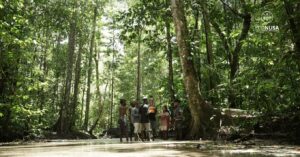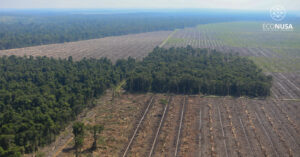
Having cruised all night long, Kurabesi Explorer boat with EcoNusa Mangrove Expedition Team on board moved closer to Mandoni Village, Kokas District, in Fakfak Regency, West Papua. The village was the day-6 destination of the expedition. Mandoni Village is dubbed “Mangrove Crab Village” due to the fact that most local people here earn their living from mangrove crab, small crab, oyster and fish.
Amidst the morning activities, EcoNusa Team got a lucky day when ran across Maria Kramandondo who was busy hunting crabs. She pedaled her boat from six in the morning to fix the crab traps along her hunting track that day.
Maria was so enthusiastic to hunt for crabs when rainy season comes. “Rainy season has many crabs due to the mixture of freshwater. It makes a good catch as I can collect one bag of 20, 30 or even 50 crabs,” said Maria.
She told that she sold the crabs to buyers who came from town. When there is no buyer, Maria will normally bring the crabs with her to Fakfak. “Sometimes I could earn IDR700,000. When there are many crabs I could earn up to IDR1 million,” she said telling when she was fortunate to get big catches.
Maria has five daughters. One went to school in Manado and now she becomes a teacher. Another daughter becomes a nun in Jayapura. In fact, the crab-generated money could afford proper education to Maria’s daughters. “Yes, true, it is the money from crab. Some earnings come from nutmeg, but crab is the most essential,” said Maria proudly as she could bring up her daughters with proper education from crabs.
Mandoni Village has quite dense mangrove ecosystem covers. Some mangrove ecosystems are pristine which is deemed primary mangrove ecosystem. Some other has been intervened by human. But Maria admitted that all local community protect the areas with mangi-mangi (a local language for mangrove). None cuts mangrove inconsiderately.
However, Maria acknowledged that sometimes she could hardly get enough crabs, given the fact that there are getting more people hunting crabs in the areas with mangi-mangi. In addition to the increasing number of populations, dry season and muddy water make the catch rare from usual.
“When there are many people, we should seek an empty hunting site. The first sees, the first gets the catch. Never get closer to each other,” she said underlining her struggles for hunting site.
As to Mandoni Village Chief, Abdul Karaman Dunduh, most Mandoni villagers cultivate nutmeg. But upon accomplishing nutmeg harvest season, they usually get back to hunt crab, oyster and fish.
Mandoni villagers commonly sell raw crabs. But, sometimes, there are people who make crab-based food, such as abon (shredded crab meat that has been boiled, seasoned and dried) or spicy crab curry. Maria also does process the crab into food. “Yes, right. I cook spicy crab curry and sell the cook to offices. One bowl of crab curry costs around IDR10,000 to IDR20,000,” Maria said. She reckoned that selling crab-processed food gives her more earnings. One crab could be chopped into parts for curry.
Considering the crabs, oysters, fish in Mandoni, mangi-mangi turns to be essential ecosystem that needs protection. “In God blessing, when there are more mangi-mangi, there will be more crabs,” said Maria concluding the chitchat with EcoNusa Mangrove Expedition Team by end of 2019.
Authors: Leo Wahyudi and Wiendy Widasari







